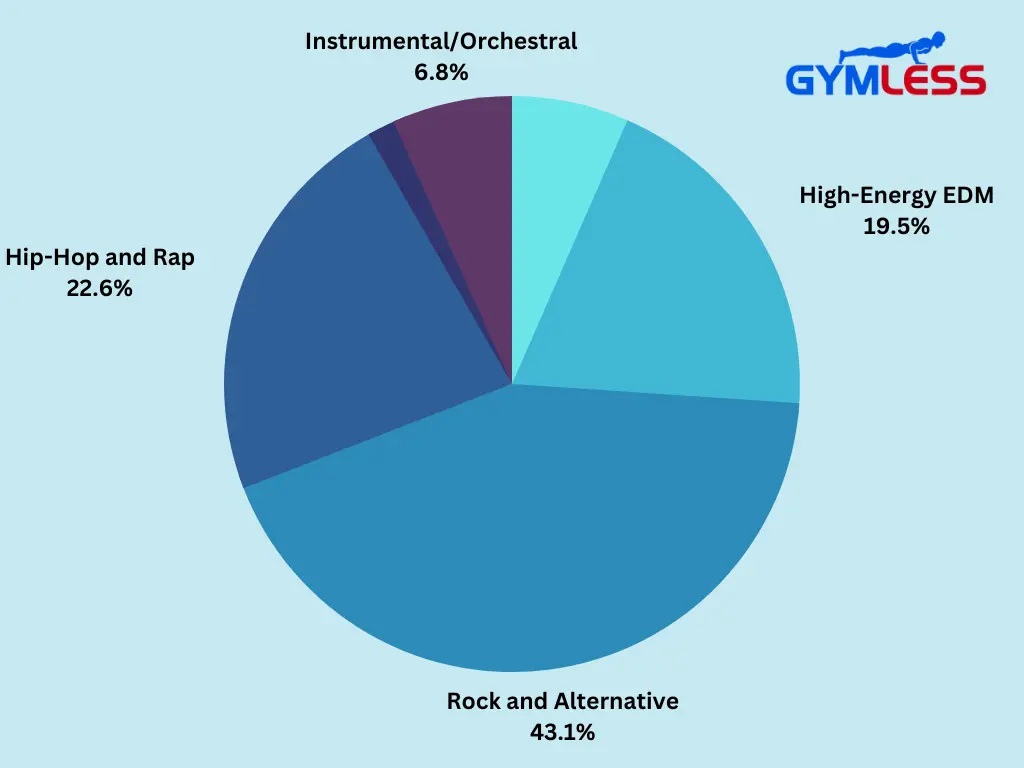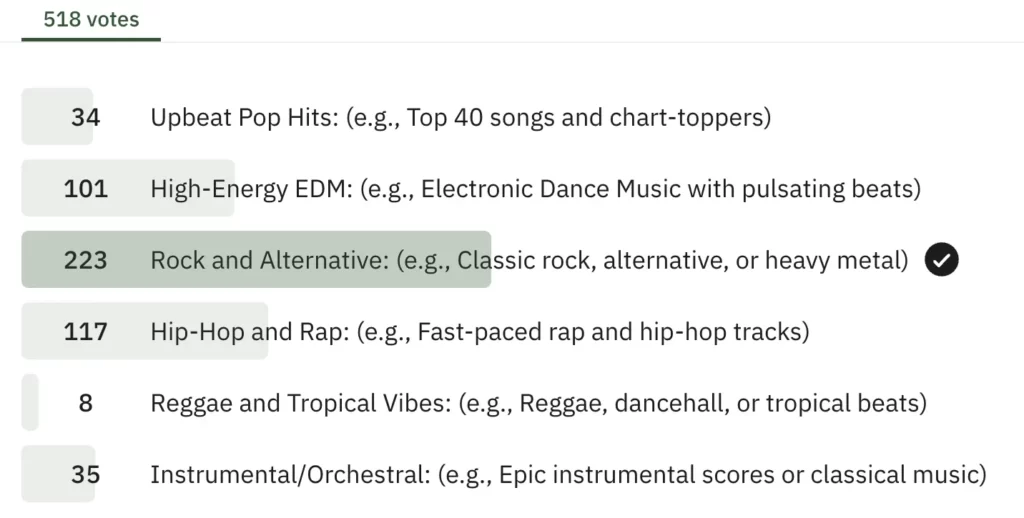
A recent poll of an online community of 288,000 users found that a plurality of respondents (43.1%) prefer listening to rock and alternative music while working out.
While power rock anthems like “Eye of the Tiger” and “We Will Rock You” are universally beloved among gym-goers, mainstream American culture has gravitated toward hip-hop and electronic music in recent years. Indeed, hip-hop and R&B music is by far the most streamed genre of music in the United States—garnering nearly 50% more streams than rock.
Even in a fitness context, previous polling results indicated that the most popular genre of music to exercise to for Americans was hip-hop.
The present survey, therefore, may be suggestive of a cultural return to rock and alternative music over other genres that currently enjoy wider radio play and popular success.
Table of Contents
Survey Results
Counting 518 votes from registered social media users, a plurality of respondents (43.1%) said that “Rock and Alternative” was their preferred choice of music while exercising. By contrast, only 22.6% preferred “Hip-Hop and Rap” and 19.5% preferred “High-Energy EDM”. Figure 1, below, displays the raw survey results upon the poll’s conclusion.

Figure 1: Survey results in numeric form
Rock and alternative music garnered a commanding 91% more of the vote share than hip-hop and rap. In fact, rock and alternative music received more responses than the next two most popular genres combined (hip-hop and EDM). The least-favored genres of music, in order, were instrumental, pop, and reggae.
The responses are listed below in percentage form and ranked from highest to lowest.
- Rock and Alternative: 43.1% (223)
- Hip-Hop and Rap: 22.6% (117)
- High-Energy EDM: 19.5% (101)
- Instrumental/Orchestral: 6.8% (35)
- Upbeat Pop Hits: 6.6% (34)
- Reggae and Tropical Vibes: 1.5% (8)
In Figure 2, below, the survey results are redisplayed as a pie chart to visualize the differences in response sizes between the various options.

Figure 2: Survey results in percentage form
Results Discussion
The survey was conducted by Gymless.org, a free educational resource for calisthenics and bodyweight fitness information.
For many, music is integral to the experience of working out. In fact, a resounding 65% of respondents have previously indicated that they would have “no motivation” to work out without music to listen to.
The present survey may suggest that a cultural reversion is taking place in which rock and alternative music are once again taking precedence among certain American audiences. According to Billboard, rap and hip-hop music has been the dominant genre of music on United States charts.
According to the survey authors, the findings shed light on a potential cultural shift within the fitness community in which rock music is reclaiming a favored position in gyms and fitness spaces. They also speak to the lasting influence of rock music.
Amine Rahal, Founder and CEO of Gymless, had this to say about the survey’s results:
“Ultimately, I expected EDM or hip-hop to receive the most responses since these types of music are what I hear in most public venues, and even on TV and in commercials. To me, these findings show the resilience of rock music as a cultural force and a timeless style of energetic music that a wide range of people can get behind when it comes time to break a sweat.”
Another of the survey’s co-authors, Liam Hunt, commented the following:
“While hip-hop has undeniably been the anthem of the mid-2010s, claiming the lion’s share of radio play and top 40 chart positions, our poll indicates that a significant 43.1% of fitness enthusiasts resonate with rock and alternative music during their workouts.
This could suggest a cultural reversion, or perhaps a renewed appreciation, towards the raw energy and spirit of rock. Hip-hop, with 22.6%, and high-energy EDM, at 19.5%, continue to hold strong ground, but it’s intriguing to observe the pendulum swinging back towards the visceral beats of rock. This ebb and flow of musical preferences not only underscores the cyclical nature of cultural trends but also highlights the deep connection between music, movement, and the mood of an era.”
While these results may be indicative of a larger cultural shift, they certainly make a statement about the longevity and appeal of rock music as an enduring feature of fitness culture. In a changing artistic and cultural landscape, rock music has stood the test of time by remaining a top choice among gym-goers and fitness enthusiasts.
Survey Methodology
The survey was held on Thursday, September 21, 2023, during business hours EST. The survey polled a population of registered social media users who follow an online fitness community and message board.
All approximately 288,000 users were polled, of which 518 submitted a formal response. The survey consisted of male and female respondents at least 13 years of age, and there were no geographical restrictions on participation.
Convenience sampling was used, and the survey results are not necessarily scientifically representative of any population. The findings of the survey are for exploratory purposes only.
Conclusion: What Our Workout Playlists Are Really Saying
Music, much like fitness, is an evolving reflection of our times. Our recent poll’s findings offer an evocative look into the current musical landscape preferred by fitness enthusiasts, signaling potential shifts in the broader culture toward rock and alternative music.
Rock and alternative music have emerged as the top choice, embraced by 43.1% of respondents. This unexpected resurgence may indicate a nostalgic return or a newfound appreciation for its visceral, raw energy. Meanwhile, hip-hop, which has held cultural dominion since the mid-2010s, appeals to 22.6% of our polled group, followed closely by the electrifying beats of EDM at 19.5%.
As we reflect on these numbers, we’re reminded that musical preferences are never just about sound; they’re emblematic of deeper societal undercurrents, memories, and emotions. As we move forward, it’ll be intriguing to witness how these trends evolve and what they reveal about our ever-changing relationship with sound and sweat.
The big takeaway? Music trends, like fashion, have a way of coming back around or mixing things up. Maybe it’s nostalgia, or perhaps we’re just rediscovering some old gems. Either way, it’s clear that the tunes we pick for our workouts are more than just background noise—they’re a reflection of where we’re at culturally and what’s resonating with us. Keep those playlists fresh and keep moving to the beat!

Liam Hunt, M.A., is a writer and fitness enthusiast with a background in endurance cycling as well as competitive ice hockey, CrossFit, powerlifting, and bodybuilding. He is certified in Exercise Theory and Resistance Training from the Nova Scotia Fitness Association (NFSA).


Leave a Reply